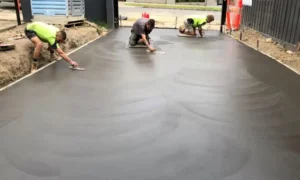A concrete catch basin is an essential component of any drainage system. It is a structure designed to collect and filter runoff water from paved surfaces such as parking lots, driveways, and sidewalks while preventing debris from entering the sewer system. Catch basins come in different sizes, shapes, and designs depending on their intended use. The purpose of determining the best size for your concrete catch basin is to ensure optimal efficiency in collecting water.
When choosing the ideal size for your catch basin, several factors must be considered. First, it’s important to consider how much runoff water needs to be collected based on the surface area of your property. A larger surface area will require a larger catch basin to prevent flooding or erosion caused by water overflow.
Secondly, you need to consider the type of soil on which the catch basin will be installed. Soil with high permeability can allow water to seep through easily; hence a smaller catch basin may suffice. However, soil with low permeability requires a larger concrete catch basin since it will take longer for the water to seep through.
Lastly, it’s crucial to factor in local regulations and guidelines when selecting an appropriate size for your concrete catch basin. Some jurisdictions have set standards that dictate what size of a catch basin should be installed based on specific criteria such as location or capacity requirements. Adhering to these standards ensures compliance with local regulations while ensuring optimal functionality of your drainage system overall.
Factors to Consider
One of the primary factors to consider while determining the best size for your concrete catch basin is the amount of water that needs to be collected. This can vary depending on several factors such as the size of your property, the nature and frequency of rainfall, and level of runoff in your area.
Another factor to keep in mind is the placement and location of your catch basin. If you have a large property with multiple structures or significant levels of foot traffic, it may be necessary to install more than one catch basin for optimal drainage. Similarly, if your property lies at an angle or has uneven terrain, it could affect how water flows through the area and where catch basins should be placed.
Finally, always consider local regulations when installing a concrete catch basin. Depending on where you live, there may be specific guidelines around sizing and installation that must be followed to ensure compliance with local laws and regulations. By taking all these factors into account while choosing a concrete catch basin size that fits your needs, you can help ensure efficient drainage and prevent costly damage from flooding or other forms of water damage over time.
Area Size
When it comes to installing a 12×12 concrete catch basin, one of the most important factors to consider is the size. The size of your catch basin will depend on several factors, including the amount and frequency of rainfall in your area, the slope or grade of your property, and the surface area you need to drain.
If you live in an area with heavy rainfall or frequent storms, you’ll need a larger catch basin that can handle more water. Similarly, if your property has a steep slope or grade, you’ll need a bigger catch basin to prevent flooding and erosion.
Another critical factor to consider when determining the size of your concrete catch basin is the surface area you need to drain. If you’re only draining a small patio or walkway, a smaller catch basin may be sufficient. However, if you’re draining an entire parking lot or commercial property with large paved areas, then a larger catch basin with more capacity will be necessary.
In conclusion, choosing the right size for your concrete catch basin requires careful consideration of several factors such as rainfall frequency and severity in your location; topography and landscape slopes; as well as intended coverage areas. It’s always best to consult with professionals who have experience designing drainage systems that meet all requirements while minimizing costs associated with installation and maintenance over time.
Drainage Paths
One important factor to consider when determining the best size for your concrete catch basin is the drainage path. The drainage path refers to the path that water takes as it flows towards your catch basin. It’s important to understand and analyze this path in order to properly determine the correct size for your catch basin.
One key consideration is the volume of water that will be flowing through the drainage path. If you have a high volume of water flowing towards your catch basin, you’ll likely need a larger catch basin to accommodate it. Homeowners from all around MIle High City like to call stormwater management services in Denver who help them figure out the best size for their catch basin. Additionally, factors such as slope and soil type can affect the flow of water and should also be taken into account when determining size.
Another consideration is any potential blockages or debris that may enter the drainage path. If there are trees or other vegetation nearby, leaves and branches could easily clog up your drain system. In this case, it may be wise to opt for a larger catch basin that can handle any potential debris without causing backups or flooding. Understanding these factors can help ensure that you choose a concrete catch basin with appropriate dimensions and capacity for your specific needs.
Rainfall Intensity
When it comes to determining the size of a concrete catch basin, one important factor to consider is rainfall intensity. This refers to the amount of rainfall that falls in a given period of time. The more intense the rainfall, the greater the amount of water that needs to be collected and diverted away from your property.
To determine rainfall intensity in your area, you can consult historical precipitation data or use local weather patterns as a guide. It’s important to note that rainfall intensity can vary greatly depending on location and season, so it’s essential to account for these factors when selecting a catch basin size.
Once you have determined your area’s average rainfall intensity, you can use this information to select an appropriate catch basin size. A larger catch basin will be able to handle higher levels of rainfall intensity and provide better protection against flooding and erosion on your property. Ultimately, taking into account rainfall intensity is crucial when selecting a concrete catch basin that will effectively manage stormwater runoff in your area.
Installation Process
When it comes to installing a concrete catch basin, choosing the right size is crucial. The catch basin should be able to handle the amount of water that flows through the drainage system without getting overwhelmed. Several factors must be taken into account when determining the appropriate size for your concrete catch basin.
The first factor is the surface area of the drainage system. The larger the surface area, the bigger your concrete catch basin needs to be. Secondly, consider how much rainfall and snowfall you typically get in your area. If you live in an area with heavy precipitation, you’ll need a larger catch basin to handle all that water.
Lastly, think about any potential future changes or expansions to your property that could impact drainage needs. It’s important to plan ahead and ensure your concrete catch basin can accommodate any future modifications.
Overall, selecting an appropriate size for your concrete catch basin during installation will prevent costly damage from flooding or other drainage issues down the line.
Cost Considerations
One of the main factors to consider when determining the best size for your concrete catch basin is the cost. The larger the catch basin, the more materials and labor costs that will be involved in its installation. This can quickly add up and impact your overall budget for the project.
However, it is important to also take into account potential future costs such as maintenance and repairs. A smaller catch basin may save money upfront, but if it becomes overwhelmed during heavy rainfall and leads to flooding or other issues, it could end up costing more in the long run.
Another cost consideration when deciding on a concrete catch basin size is any regulatory requirements or permits that may be needed. Depending on your location and specific project specifications, there may be certain size guidelines or regulations that must be followed.
Failure to comply with these regulations could result in fines or other penalties which would ultimately increase project costs. Additionally, obtaining necessary permits can come with associated fees and expenses that should also be factored into your overall budget planning for this aspect of your construction project.
Maintenance Requirements
One of the most critical considerations when deciding on the size of your concrete catch basin is its maintenance requirements. The larger the catch basin, the more time and effort will be needed to maintain it. Regular maintenance is essential to keep your catch basin functioning correctly and avoid blockages that can cause flooding or other drainage issues.
It’s crucial to consider factors such as how often you will need to clean out debris, sediment buildup, and other contaminants from your catch basin. Additionally, how accessible the catch basin is for cleaning purposes should be taken into consideration.
Another key factor in determining maintenance requirements is where your concrete catch basin is located. Catch basins situated in high-traffic areas may require more frequent cleaning than those in less busy locations. It’s also important to consider any potential environmental factors that could affect maintenance needs, such as heavy rainfall or seasonal changes in weather conditions. By carefully weighing all these factors, you can determine the best size for your concrete catch basin that meets both your drainage needs and maintenance requirements.


































